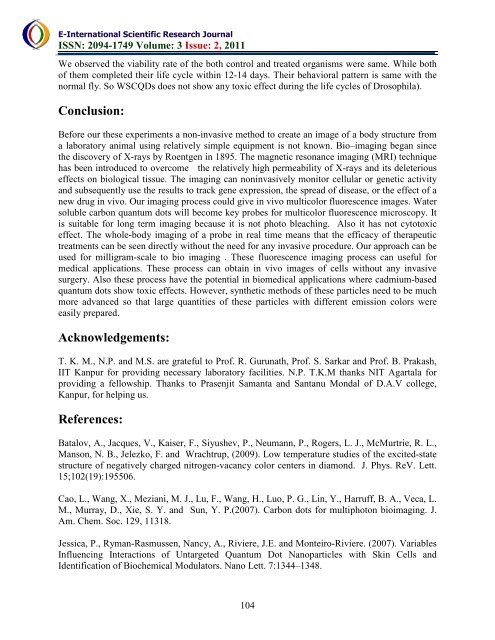download the full article here - E-International Scientific Research ...
download the full article here - E-International Scientific Research ...
download the full article here - E-International Scientific Research ...
You also want an ePaper? Increase the reach of your titles
YUMPU automatically turns print PDFs into web optimized ePapers that Google loves.
E-<strong>International</strong> <strong>Scientific</strong> <strong>Research</strong> Journal<br />
ISSN: 2094-1749 Volume: 3 Issue: 2, 2011<br />
We observed <strong>the</strong> viability rate of <strong>the</strong> both control and treated organisms were same. While both<br />
of <strong>the</strong>m completed <strong>the</strong>ir life cycle within 12-14 days. Their behavioral pattern is same with <strong>the</strong><br />
normal fly. So WSCQDs does not show any toxic effect during <strong>the</strong> life cycles of Drosophila).<br />
Conclusion:<br />
Before our <strong>the</strong>se experiments a non-invasive method to create an image of a body structure from<br />
a laboratory animal using relatively simple equipment is not known. Bio–imaging began since<br />
<strong>the</strong> discovery of X-rays by Roentgen in 1895. The magnetic resonance imaging (MRI) technique<br />
has been introduced to overcome <strong>the</strong> relatively high permeability of X-rays and its deleterious<br />
effects on biological tissue. The imaging can noninvasively monitor cellular or genetic activity<br />
and subsequently use <strong>the</strong> results to track gene expression, <strong>the</strong> spread of disease, or <strong>the</strong> effect of a<br />
new drug in vivo. Our imaging process could give in vivo multicolor fluorescence images. Water<br />
soluble carbon quantum dots will become key probes for multicolor fluorescence microscopy. It<br />
is suitable for long term imaging because it is not photo bleaching. Also it has not cytotoxic<br />
effect. The whole-body imaging of a probe in real time means that <strong>the</strong> efficacy of <strong>the</strong>rapeutic<br />
treatments can be seen directly without <strong>the</strong> need for any invasive procedure. Our approach can be<br />
used for milligram-scale to bio imaging . These fluorescence imaging process can useful for<br />
medical applications. These process can obtain in vivo images of cells without any invasive<br />
surgery. Also <strong>the</strong>se process have <strong>the</strong> potential in biomedical applications w<strong>here</strong> cadmium-based<br />
quantum dots show toxic effects. However, syn<strong>the</strong>tic methods of <strong>the</strong>se p<strong>article</strong>s need to be much<br />
more advanced so that large quantities of <strong>the</strong>se p<strong>article</strong>s with different emission colors were<br />
easily prepared.<br />
Acknowledgements:<br />
T. K. M., N.P. and M.S. are grateful to Prof. R. Gurunath, Prof. S. Sarkar and Prof. B. Prakash,<br />
IIT Kanpur for providing necessary laboratory facilities. N.P. T.K.M thanks NIT Agartala for<br />
providing a fellowship. Thanks to Prasenjit Samanta and Santanu Mondal of D.A.V college,<br />
Kanpur, for helping us.<br />
References:<br />
Batalov, A., Jacques, V., Kaiser, F., Siyushev, P., Neumann, P., Rogers, L. J., McMurtrie, R. L.,<br />
Manson, N. B., Jelezko, F. and Wrachtrup, (2009). Low temperature studies of <strong>the</strong> excited-state<br />
structure of negatively charged nitrogen-vacancy color centers in diamond. J. Phys. ReV. Lett.<br />
15;102(19):195506.<br />
Cao, L., Wang, X., Meziani, M. J., Lu, F., Wang, H., Luo, P. G., Lin, Y., Harruff, B. A., Veca, L.<br />
M., Murray, D., Xie, S. Y. and Sun, Y. P.(2007). Carbon dots for multiphoton bioimaging. J.<br />
Am. Chem. Soc. 129, 11318.<br />
Jessica, P., Ryman-Rasmussen, Nancy, A., Riviere, J.E. and Monteiro-Riviere. (2007). Variables<br />
Influencing Interactions of Untargeted Quantum Dot Nanop<strong>article</strong>s with Skin Cells and<br />
Identification of Biochemical Modulators. Nano Lett. 7:1344–1348.<br />
104

















